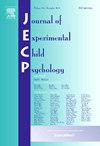生物学是命中注定的吗?儿童对生理和心理特征信念的一致性。
IF 2
2区 心理学
Q3 PSYCHOLOGY, DEVELOPMENTAL
引用次数: 0
摘要
在成人中,生物原因通常与不变性联系在一起。然而,儿童在成长过程中何时会将这些想法与身体和心理特征的推理联系起来,以及儿童是否会因领域不同而推理不同,这些问题仍不清楚。了解这一点对阐明儿童关于身体和心理的概念具有重要意义。先前的研究表明,儿童在 8 岁左右可能开始对心理特征有更复杂的分化理解。因此,在研究 1a 中,我们考察了美国三年级学生对身体和心理特征的遗传性和可塑性的推理,以及他们在每个领域中的想法是否连贯一致。在研究 1b 中,我们进一步研究了这种差异化理解的稳健性,探讨了参与提供生理特征简化信息的课程是否会影响对心理特征的思考。结果显示,三年级学生在推理特质的遗传性和可塑性时表现出了很强的连贯性。与心理特征相比,孩子们一致认为物理特征的遗传性更强,可塑性更弱,而且孩子们关于可遗传性和可塑性的想法在每个领域中都表现出一致的联系。此外,接触有关物理特征的科学教学并没有改变儿童对心理特征的遗传性和可塑性较低的看法。因此,到 8 岁时,儿童已能以理论上一致的方式清楚地区分身体和心理。尽管如此,在与儿童谈论智力等能力方面的亲子相似性时,关于可遗传性和不可改变性的信念之间的共变性应引起警惕,以免一些儿童推断出他们的能力无法通过努力得到提高。本文章由计算机程序翻译,如有差异,请以英文原文为准。
Is biology destiny? The coherence of children’s beliefs about physical and psychological traits
In adults, biological causes are commonly associated with immutability. However, it remains unclear when during their development children coherently connect these ideas in relation to reasoning about physical and mental traits and whether children reason differently by domain. Understanding this is relevant to illuminating children’s conceptions about the body versus the mind. Prior work has suggested that a more sophisticated differentiated understanding of psychological traits may begin to emerge around 8 years of age. In Study 1a, therefore, we examined U.S. third graders’ reasoning about the inheritance and malleability of physical and mental traits and whether their ideas coherently covary within each domain. In Study 1b, we further investigated the robustness of this differentiated understanding by exploring whether participating in a curriculum that presented simplified information about physical traits affected thinking about mental traits. Results reveal that third graders display robust coherence in their reasoning about trait inheritance and malleability. Children consistently judged physical traits as more inherited and less malleable than mental traits, with children’s ideas about inheritability and malleability showing consistent connections within each domain. Moreover, exposure to science teaching about physical traits did not alter children’s perception that mental traits are less inherited and more malleable. By 8 years of age, therefore, children clearly distinguish body from mind in theoretically coherent ways. Nevertheless, the covariance between beliefs about inheritability and immutability should provoke caution when talking to children about parent–child resemblances in capacities like intelligence lest some children infer that their abilities cannot be improved through effort.
求助全文
通过发布文献求助,成功后即可免费获取论文全文。
去求助
来源期刊

Journal of Experimental Child Psychology
Multiple-
CiteScore
4.50
自引率
7.70%
发文量
190
期刊介绍:
The Journal of Experimental Child Psychology is an excellent source of information concerning all aspects of the development of children. It includes empirical psychological research on cognitive, social/emotional, and physical development. In addition, the journal periodically publishes Special Topic issues.
 求助内容:
求助内容: 应助结果提醒方式:
应助结果提醒方式:


